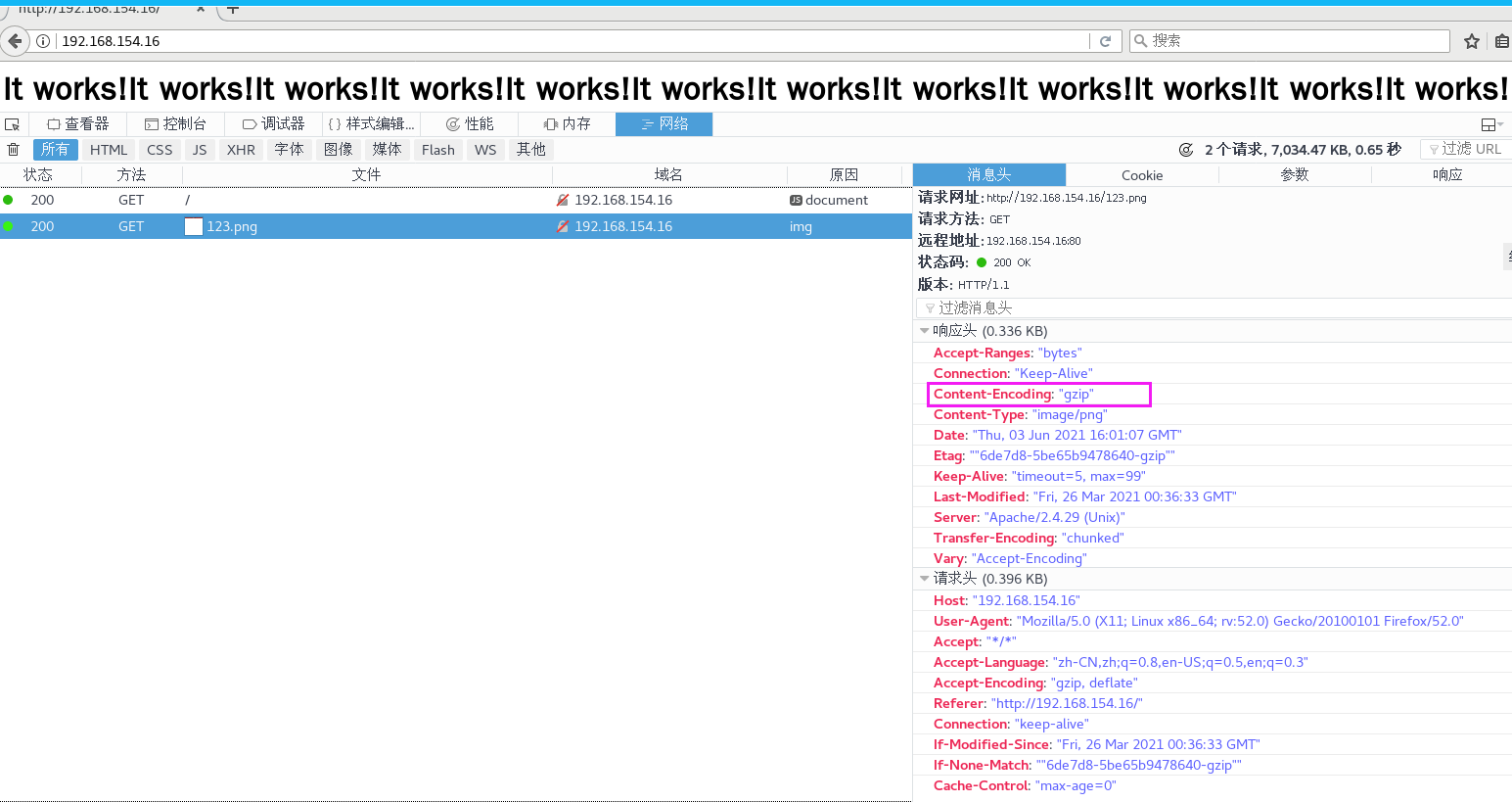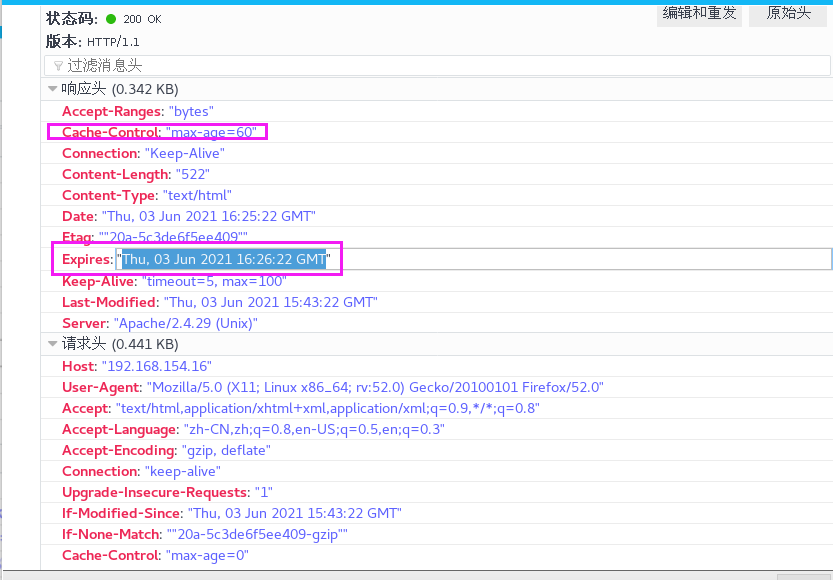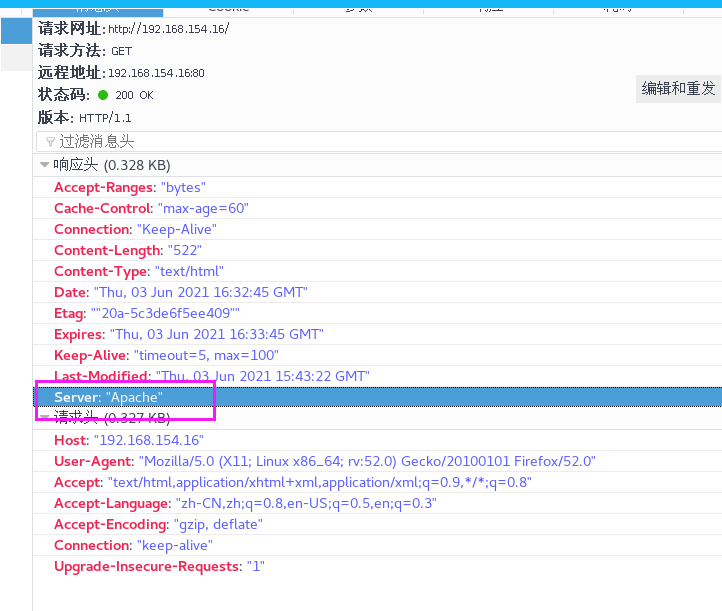Web page compression
1. Check whether mod is installed_ Deflate module
apachectl -t -D DUMP_MODULES| grep "deflate"
2. If mod is not installed_ Deflate module, recompile and install Apache, add mod_deflate module
systemctl stop httpd.service cd /usr/local/httpd/conf mv httpd.conf httpdno.conf.bak yum -y install gcc gcc-c++ pcre pcre-devel zlib-deve #Add mod deflate module make -j2 && make install
3. Configure Mod_ Enable module def
vim /usr/local/httpd/conf/httpd.conf --52 that 's ok--modify Listen 192.168.154.16:80 --105 that 's ok--note off LoadModule deflate module modules/mod deflate. so . #Enable mod_deflate module --197 that 's ok--Uncomment, modify Serve rName www.kgc.com: 80 --Last line add-- <IfModule mod_deflate.c> AddOutputFilterByType DEFLATE text/html text/plain text/css text/xml text/javascript text/jpg text/png #Represents what kind of content to enable gzip compression DeflateCompressionLevel 9 #Represents the compression level, ranging from 1 to 9 SetOutputFilter DEFLATE #On behalf of enabling deflate module to gzip compress the output of this site </IfModule>
4. Check the installation and start the service
apachectl -t #Verify that the configuration file is configured correctly apachectl -t -D DUMP_MODULES | grep "deflate" #Check Mod_ Is deflate module installed deflate module (shared) #Installed correct results systemctl start httpd.service
5. Test Mod_ Whether deflate compression takes effect
cd /usr/local/httpd/htdocs 123 first.png File transfer/usr/local/httpd/htdocs Under the directory vim index.html <html> <body> <h1> It works!It works!It works!It works!It works!It works!It works!It works!It works!It works!It works!Itworks!It works!It works!It works!It works!It works!It works!It works!It works!It works!It works!It works!It works! It works!It works!It works!It works!It works!It works!It works!It works!It works!It works!It works!It works!It works! It works!It works!It works!It works!It works!It works!It works!It works!It works!It works!It works!It works!It works!works! </h1> <img src="123.png"/> </body> </html>
6. Verification
In Linux system, open Firefox browser and right-click to view elements
Select network - > select HTML, WS, other
visit http://192.168.154.16 , double-click the 200 response message to see that the response header contains content encoding: gzip
Method 2:
Install microsoft.com successively in Windows system Net4 and fiddler software, open Fiddler software
Select inspectors - > select Headers
Browser access http://192.168.154.16 , double-click the 200 response message to view the content encoding: gzip

Web cache
1. Check whether it is installed
mod expires module
apachectl -t -D DUMP_MODULES | grep "expires"
2. If mod is not installed_ Expires module, recompile and install Apache, add mod_ expires module
systemctl stop httpd.service cd /usr/local/httpd/conf mv httpd.conf httpd.conf.bak1 yum -y install gcc gcc-c++ pcre pcre-devel zlib-deve cd /opt/httpd-2.4.29/ ./configure \ --prefix=/usr/local/httpd \ --enable-so \ --enable-rewrite \ --enable-charset-lite \ --enable-cgi \ --enable-deflate \ --enable-expires #Add mod expires module make -j2 && make install
3. Configure mod_ expires module enabled
vim /usr/local/httpd/conf/httpd.conf --52 that 's ok--modify Listen 192.198.154.16:80 --111 that 's ok--note off LoadModule expires_ module modules/mod_ expires. so #Enable mod_ expires module --199 that 's ok--Uncomment, modify ServerName www.kgc.com: 80 --Last line add-- <IfModule mod_expires.c> ExpiresActive On #Turn on Web page caching ExpiresDefault "access plus 60 seconds" #Set cache for 60 seconds </IfModule>
4. Check the installation and start the service
apachectl -t #Verify that the configuration file is configured correctly apachectl -t -D DUMP_MODULES | grep "expires" #Check that the mod deflate module is installed deflate module (shared) #Installed correct results systemctl start httpd.service
5. Test whether the cache is effective
cat /usr/local/httpd/htdocs/index.html
Method 1:
In Linux system, open Firefox browser and right-click to view elements
Select network - > select HTML, WS, other
visit http://192.168.154.16 , double-click the 200 message to see that the response header contains the Expires item
Method 2:
Install microsoft.com successively in Windows system Net4 and fiddler software, open Fiddler software
Select inspectors - > select Headers
Browser access http://192.168.154.16 , double-click the 200 message to view the Expires item

Hide version information
vim /usr/local/httpd/conf/httpd.conf --491 that 's ok--note off Include conf/extra/httpd-default. conf vim /usr/local/httpd/conf/extra/httpd-default.conf --55 that 's ok--modify ServerTokens Prod #Change the original Full to Prod, only display the name, no version #ServerTokens indicates whether the response header field returned by the Server to the client contains information about the Server OS type and the compiled module description. systemctl restart httpd. service
Browser access http://192.168.154.16 , double-click the 200 message to view the Server item

Apache anti-theft chain
1. Check whether mod rewrite module is installed
apachectl -t -D DUMP_MODULES | grep "rewrite"
2. If mod is not installed_ Rewrite module, recompile and install
Apache add mod__ Rewrite Module
systemctl stop httpd. service cd /usr/local/httpd/conf mv httpd.conf httpd.conf.bak2 yum -y install gcc gcc-c++ pcre pcre-devel zlib-devel cd /opt/httpd-2.4.29/ ./configure \ --prefix=/usr/local/httpd \ --enable-so \ --enable-rewrite \ --enable-charset-lite \ --enable-cgi \ --enable-deflate \ --enable-expires #Add mod rewrite Module make -j2 && make install
3. Configure mod_ rewrite Module enabled
vim /usr/local/httpd/conf/httpd.conf
--157 that 's ok--note off
LoadModule rewrite_ module modules/mod_ rewrite. so
-224 that 's ok--
<Directory "/usr/local/httpd/htdocs">
Options Indexes FollowSymLinks
AllowOverride None
Require all granted
RewriteEngine On #Open the rewrite function and add mode_rewrite module content
RewriteCond %{HTTP_REFERER} !^http://kgc.com/.*$ [NC] # set matching rules
RewriteCond %{HTTP_REFERER} !^http://kgc.com$ [NC]
RewriteCond %{HTTP_REFERER} !^http://www.kgc.com/.*$ [NC]
RewriteCond %{HTTP_REFERER} !^http://www.kgc.com/$ [NC]
RewriteRule .*\.(gif|jpg|swf)$ http://www.kgc.com/error.png # set Jump Action
</Directory>RewriteCond tells {HTTP reference}^ http:/ /www. kgc. com/.$ Field meaning of [NC]:
"Each {httpreferrer}": the URL that stores a link, indicating which link to access the required web page from.
"! ^": indicates that it does not start with the following string.
" http://www. kgc. com ": is the path of this website, matching according to the whole string.
“.KaTeX parse error: Can't use function '\.' in math mode at position 48: … RewriteRule .*\ ̲.̲ (gifljpg|swf) http:/ /www.kgc. com/error. Meaning of PNG field:
"." means to match one character.
"*" means to match 0 to more than one character, which is the same as "." Together, it means to match any character in front of 0 to multiple times. If it is 1 to multiple times, it can be represented by "+".
“.”: The "\" here is the escape character, " "Represents the meaning of the symbol". "Because". "Is a regular character in the instruction and has a corresponding meaning,
If you need to match, you need to add an escape character "\" in front of it. If you need to match other regular characters, do the same.
"(gifljpg|swf)": means to match any one of "gif", "jpg" and "SWF", and "$" means to end. The final rule is ". gif", ". jpg", " Swf "end,
It is preceded by a string of 1 to more than one character, that is, a file matching the image type.
"Http: / / www.kgc. COM / error. PNG": indicates forwarding to this path.
The meaning of the whole configuration is to display error when accessing the image file of this site with a website domain name other than this site Png this picture.